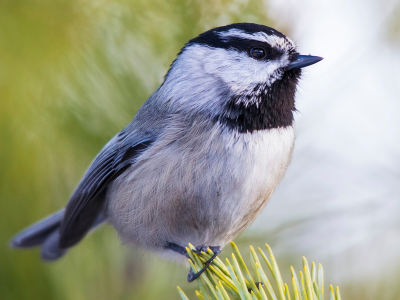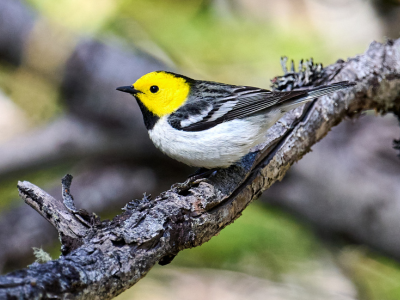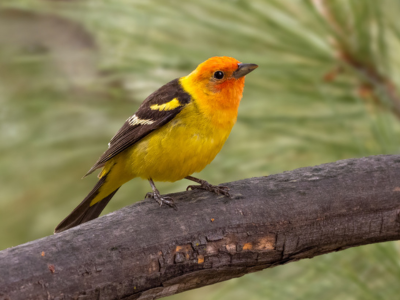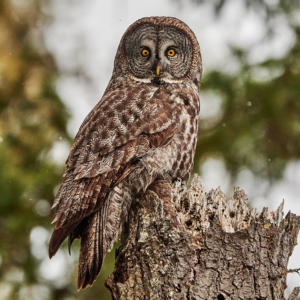Researchers have found that low to moderate-severity fires not only benefit many bird species in the Sierra Nevada, but these benefits may persist for decades. In addition to a handful of bird species already known to be “post-fire specialists”, a broad variety of other more generalist species, like Dark-eyed Juncos and Mountain Chickadees, clearly benefited from wildfire. This research will help land managers make decisions about how to manage forests and fires as they face a changing fire regime.

A Mountain Chickadee. Photo by Daniel Arndt.
In the study, published in the journal Fire Ecology, researchers from The Institute for Bird Populations, the National Park Service, and UCLA examined bird monitoring data spanning two decades from Yosemite, Sequoia, and Kings Canyon National Parks for 42 species, and high-resolution fire history data for up to 35 years before the collection of the bird data. They found that 28 of the 42 bird species had higher population densities in areas that had been burned, and for most of these species, population densities remained higher for decades after the fire. The positive effect of fire lasted for at least 35 years for 11 species. Only 5 of the 42 species showed a negative (1 species) or mixed effects (4 species) of fire on population density.
In the last few decades, the fire regime in the Sierra Nevada has been changing. Historically, fires in the region were more frequent, low and mixed-severity fires often managed by Indigenous people. These fires helped maintain forests dominated by larger, older trees with more open understories. After the 1870s, settlers ended Indigenous cultural burning practices and began suppressing naturally occurring fires. More recently, a warmer climate, increased drought, and the accumulation of fuel due to this fire suppression have increased the extent and frequency of high-severity fire on the Sierra landscape. Now, forest managers throughout much of the region are using controlled burns and other fuel reduction techniques to try to stall the current trend towards large, high-severity fires, sometimes referred to as “megafires.”

A Hermit Warbler. Photo by Frank D. Lospalluto.
The benefits of certain types of fire for wildlife are increasingly recognized, but lead author Dr. Chris Ray, of The Institute for Bird Populations, said the researchers were most surprised by how long fire affected bird abundance. “Given the effects of fire on the nature and structure of bird habitats, and the long post-fire process of vegetative succession, maybe it's not too surprising that birds are responding to fires for so long,” says Ray. “But even low-severity burns had lasting effects on some species: for example, Western Tanager and Hermit Warbler were much more abundant at points that had experienced a low-severity burn 35 years ago than at points that never burned in the previous 35 years.”
Ray emphasizes that 97.5% of the study’s sampling locations in burned areas were in low to moderate severity burns. “Our results don't necessarily apply to the very large and high-severity fires that have been occurring more often in these landscapes in recent years,” she notes. Likewise, the 42 bird species included in this study were relatively common ones, so “these results don't necessarily apply to some of the species that are rare in these landscapes, because we couldn't apply our data-hungry statistical models to species that we didn't observe very often.”
These results suggest that managing forests to create a mosaic of fire return intervals and burn severities, also known as “pyrodiversity,” should benefit the majority of the birds in the forest. Ray notes that there was a strong trend toward more positive effects in burns of moderate severity, compared with burns of low severity. “Land managers might be heartened to hear that many birds might benefit even from burns that aren't all low-severity,” says Ray.

A Western Tanager. Photo by Julio Mulero.
This study would not have been possible without the National Park Service’s Inventory and Monitoring (I & M) Program. The bird population density data used in this study were collected as part of the program, which conducts long-term ecological monitoring within the parks. Since 1998, the I & M Program has gathered information that helps park managers make sound, data-backed decisions. I & M data is also a valuable resource for scientists studying ecological processes, like fire, in the National Parks, which can serve as natural laboratories that are relatively undisturbed by human activities. Unfortunately, funding for The Institute for Bird Populations to conduct the bird monitoring portion of the Inventory and Monitoring Program in the Sierra Nevada parks was cut following the 2025 field season.






